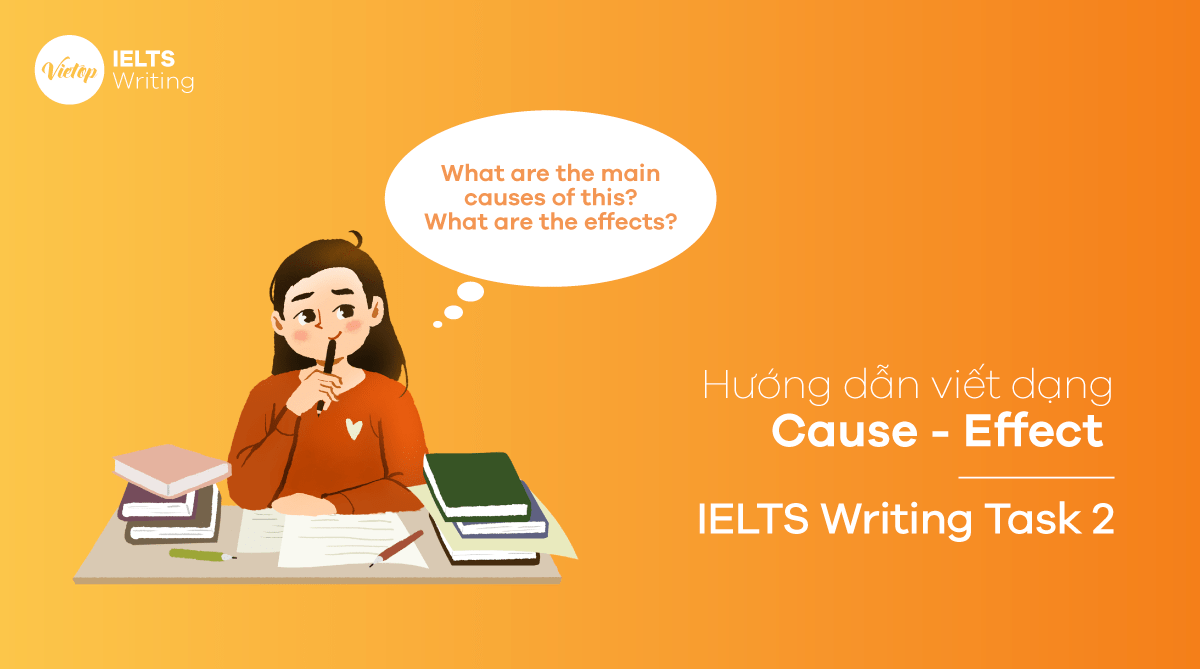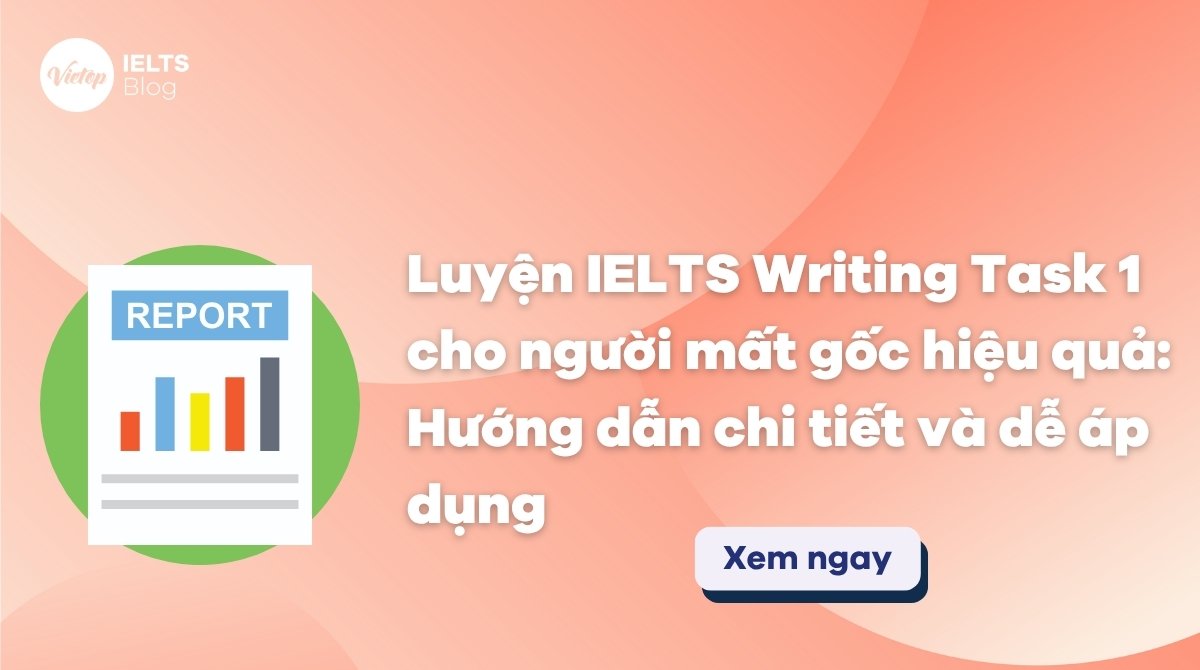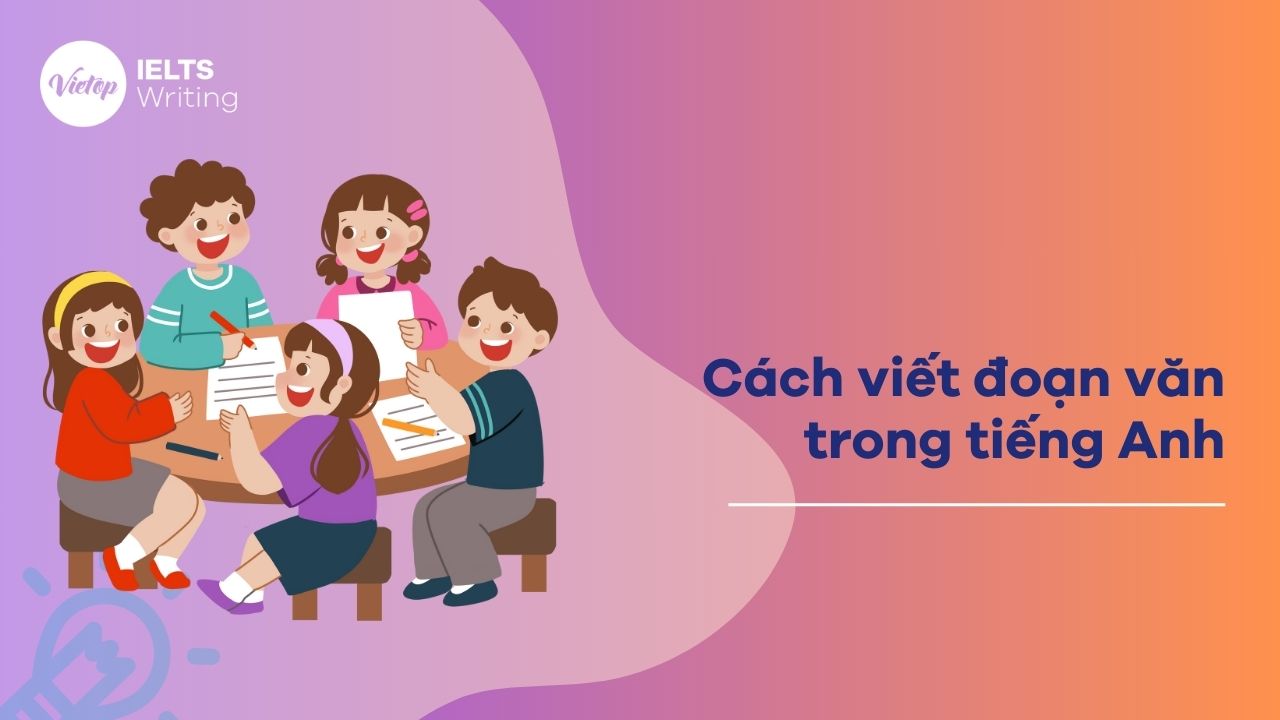Trong bài viết này Vietop English sẽ hướng dẫn bạn cách viết Cause and Effect Essay trong bài thi IELTS Writing Task 2 một cách dễ hiểu và chi tiết nhất nhé!
A. Cách nhận biết dạng Cause – Effect
Ở dạng bày này, thí sinh sẽ được hỏi về nguyên nhân và giải pháp của một vấn đề. Dưới đây là những câu hỏi thường gặp dạng bài này:
– In many countries, there is a problem with declining quality of air and water from both industry and construction. What measures can be taken to prevent this?
– Consumers are faced with increasing numbers of advertisements from competing companies. To what extent do you think consumers are influenced by advertisements? What measures can be taken to protect them?
– More and more animals are on the verge of extinction and others are on endangered list. What are reasons for this? What can be done to solved this problem?
B. Cách lên ý tưởng cho dạng Cause – Effect

- Cause: Nguyên nhân đâ phần liên quan đến những hoạt động của con người. Những thói quen thường ngày hay phong tục tập quán của con người chính những nguồn nguyên nhân rất dễ để lên ý tưởng cho nguyên nhân. Lên ý tưởng ít nhất là hai nguyên nhân nếu phần Cause được hỏi.
- Effect: Ảnh hưởng tiêu cực hay tích cực đến PEOPLE (Người), SOCIETY (Xã hội), GOVERNMENT (Chính phủ) hay INDIVIDUAL (Bản thân) sẽ là những nguồn ảnh hưởng dễ lên ý tưởng. Lên ý tưởng ít nhất hai ảnh hưởng nếu phần Effect được hỏi.
Solution: Mọi nguyên nhân và ảnh hưởng đều có giải pháp để giải quyết. Liên hệ nguyên nhân hay ảnh hưởng và những đôi tưởng bị tác động đề ra những giải pháp. Lên ý tưởng cho giải pháp ứng với số nguyên nhân hay ảnh hưởng được đề cập.
C. Cấu trúc của bài Cause – Effect
1. Cause & Effect
INTRODUCTION
BODY PARAPRAPH 1 – CAUSES
BODY PARAPRAPH 2 – EFFECTS
CONCLUSION
2. Cause & Solutions
INTRODUCTION
BODY PARAPRAPH 1 – CAUSES
BODY PARAPRAPH 2 – SOLUTIONS
CONCLUSION
D. Phân tích bài mẫu
Some businesses find that their new employees lack basic interpersonal skills such as cooperative skills. What are the causes? Suggest some solutions.
Sample
Cooperative communication has been undermined in the present day’s world of work, with many employers claiming that their staff do not have the interpersonal skills required to handle a job well. Reasons for this include the abuse of technology and the sheltered upbringing a worker might have, and several measures could be taken to solve this problem.
Excessive use of technological devices is one reason attributable to the deterioration in interpersonal skills among workers. Technology has made verbal communication redundant; many aspects of our life, from ordering a pizza, socializing with friends, learning a new language or even physical training can be done without conversations.
As a result, workers nowadays, especially young ones, find themselves unaccustomed to talking to their colleagues in person, or prefer conversing digitally.
Furthermore, young people in recent years appear to be overprotected compared to their predecessors 10-20 years ago. Research indicates that today’s millennials, especially in collectivistic countries, are more inclined towards living under the protection of their parents.
In other cases, some parents adopt a very easy-going approach that allows their children to do whatever they want to. Such safeguarding and permissiveness may result in either an inhibited worker who is unable to strike up a proper conversation, or a self-centered one who does not want to cooperate with others in assignments that require teamwork.
One solution to this problem would be to promote digital wellbeing, that is, to know how to harness technology in a moderate manner. Having a 30-day no-social-media challenge among workers in a company, for example, would be a fun way of reducing the amount of time wasted for social networking sites.
Public places such as parking spaces or cafeterias can also help by setting up boards and signs with inspirational words promoting the power of interpersonal communication and teamwork.
From an educational perspective, parents and teachers should take a less protective, more group-engaging approach towards teaching youngsters.
Children should be taught to work in groups so that they can socialize more with their friends and cherish collaboration. Early exposure to different personality traits can help a person be much better prepared for their future career.
In conclusion, misuse of technology and families’ overprotection are the two main reasons for the lack of interpersonal skills among workers. Promoting moderate use of technology and early education can be viewed as efficient ways of alleviating this problem.
Vocabulary highlights:
- undermine (v): làm cho suy yếu
- sheltered upbringing (n) sự nuôi dưỡng bảo bọc
- verbal communication (n): giao tiếp bằng lời nói
- unaccustomed to (ving) (adj): không quen với
- converse (v) nói chuyện, giao tiếp
- predecessor (n) người đi trước, người thế hệ trước
- collectivistic (adj) có tính tập thể, cộng đồng (trái với individualistic)
- safeguarding (n) sự bảo bọc
- permissiveness (n) sự dễ dãi
- inhibited (adj) nhút nhát, ngại giao tiếp
- self-centered (adj) ích kỉ, tự cho mình là quan trọng
- digital wellbeing (n) sự lành mạnh trong việc sử dụng công nghệ
- harness (v) technology: tận dụng công nghệ
- cherish (v): trân trọng
- early exposure (n): sự tiếp xúc sớm
Tham khảo: Trọn bộ đề IELTS Writing Task 1 và IELTS Writing Task 2 qua từng năm
Muốn tự tin chinh phục dạng bài Cause and Effect và đạt điểm cao trong IELTS Writing Task 2? Đăng ký ngay khóa luyện thi IELTS 1 kèm 1 của Vietop để được hướng dẫn chi tiết và luyện tập với nhiều đề thi mẫu!
E. Từ vựng hay dùng trong dạng bài Cause – Effect
- A cause of/ A reason for X: nguyên nhân của X
- Affects/ influences: ảnh hưởng
- Leads to/ gives rise to/ brings about: dẫn đến
- To be affected/ influenced by X: bị ảnh hưởng bởi X
- To be caused by/ produced by/ result from X: được gây ra bởi X
- To be a consequence of/ to be a result of/ to be due to the effect of X: do X gây ra
- As a result of/ As a consequence of X: Theo hệ quả mà X mang lại
- Consequently,/ Thus,/ Therefore,/ Hence,/ For this reason: Do đó
- Owing to/ On account of/ Because of/ Due to the fact that: vì
- One of the causes/ The reason is that: Nguyên nhân đó là
- Because/ Since/ As: vì
- Due to this/ Because of/ Owing to X: Vì X
- Leading to X: dẫn tới X

Chúc các bạn học tập tốt với cách viết dạng Cause – Effect – IELTS Writing Task 2 ở trên đây nhé. Nếu có thắc mắc bạn có thể để lại bình luận bên dưới bài viết này nhé.
Bên cạnh đó, các bạn có thể tham khảo thêm các cách viết cho dạng bài Writing Task 2 sau:
- Cách viết dạng Opinion (Agree or Disagree)
- Cách viết dạng Advantages and Disadvantages
- Cách viết dạng Discussion (Discuss both views)
- Cách viết dạng Two-part Question/ Double Question
- Cách viết dạng Problem and Solution
- Cách viết dạng Positive & Negative
- Phân tích bài mẫu dạng “to what extent”- Ads for children
Hi vọng cách viết Cause and Effect Essay – IELTS Writing Task 2 sẽ giúp bạn học tập ôn luyện thi IELTS thật tốt nhé.
Vietop English









